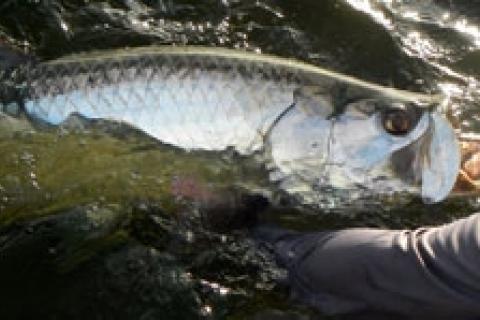
 My strike/hookup/release ratio on the silver king remains fairly high, compared to the fabled averages and there's been based on lots of years of traveling to different tarpon destinations and trying out different methods. In order to increase your own personal ratio, you might want to try the following:
My strike/hookup/release ratio on the silver king remains fairly high, compared to the fabled averages and there's been based on lots of years of traveling to different tarpon destinations and trying out different methods. In order to increase your own personal ratio, you might want to try the following:
- Immediately give up the braided line and go back to monofilament. Yes, braid transmits more energy than mono on the strike to sink the hook, but its unstretching quality slingshots the hook (more than mono) back at the angler on the jump. Guides love braid and circle hooks for their newbie customers who simply need to reel down. Good perhaps for live or dead bait, but a dull business of starting the battle by reeling without the vaunted sweep of the rod. A compromise might be cofilament, but I vote for mono!
- Give up all weighty artificials, as they give tarpon way too much leveraged weight to throw out of their mouths on the jump. There is no reason to use any plugs with treble hooks unless you enjoy mangling fish: 6 or 9 hook points endangers the tarpon's eye for short-lived but mauling moments. Use a fly as an ideal template when constructing your artificial offerings, be they should be bucktail, feathers or modern plastics. Consider building breakaway weights on your swimming plastics wherever you are.
- Lighten your leader as the fish get smaller. I often use 30-pound fluorocarbon in 6-foot lengths tied to a doubled 12-pound line for fish up to 50 pounds. The long leader arrangement helps to deal with chafing against the length of the fish's body while I use MAXIMUM PRESSURE.
- Do not forget the "Down and Dirty" — try to tire and upend your tarpon as quickly as you can so the fish can survive. Go for the quick knockout for the sake of the fish. Believe it or not, tarpon can be more fragile than redfish when the battle is over.
- For further reference consult: www.flatsfishingonline.com or www.fishingfloridasflats.com.
- 3474 views

